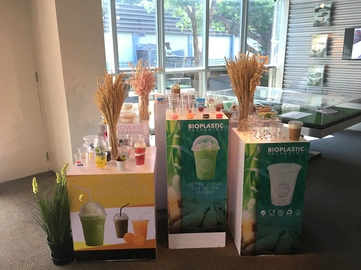Condemned to circularity: Thailand's emerging bioplastic industry
May 06, 2020.
Waste bags on the streets of Bangkok, overloaded dumping sites, plastic waste in national parks and on the country’s beaches: Thailand faces a considerable waste management challenge.
This applies in particular to plastic waste from single use items. Moreover, Thailand is the world’s sixth largest plastic waste polluter of the oceans. For these reasons, the Thai government is attempting to phase out a number of single use plastic items, such as bottles, bottle caps, straws and plastic bags (effective from January 2020). Promoted as a future industry in Thailand’s Bio-Circular-Green Economy model, Thailand’s bioplastic industry benefits from abundant supplies of agricultural feedstock: sugarcane and cassava.
Recent field research on Thailand’s bioplastic industry development explored the degree to which plastics based on natural feedstock can provide an alternative to conventional, oil-based plastics, as well as the drivers and constraints of this potential change. The research explored policy and regulatory aspects, end-of-life solutions, biodegradability, and compostability of bioplastic products in soil and marine environments.
Production-related aspects
Global bioplastic production capacity is projected to increase from 2.1 million tons in 2018 to 2.6 million tons in 2023. Early study results indicate that domestic demand for bioplastic has so far been limited, mainly due to its relatively high price. Around 95% of Thailand’s annual production of around 75,000 to 100,000 tons of the bioplastics PBS (polybutylene succinate) and PLA (polylactic acid) are exported.
Our research findings indicate major constraints to the use and production of bioplastics in Thailand’s different economic sectors including the high production costs for bioplastic as compared to those for oil-based plastics. While the current market price for a ton of conventional PE (polyethylene) ranges in between 1,200 to 1,600 USD per ton, one ton of PLA from locally-sourced sugarcane or cassava is approximately three times higher. This poses a major obstacle to the increased use of bioplastic products by domestic converters and manufacturers along the value chain. Due to the relatively cost-intensive biochemical production processes of bioplastics in Thailand, only larger petro-chemical conglomerates have so far invested in the production of plastics based on natural feedstock. For small and medium-sized enterprises contemplating a transition to bioplastics production, high investment costs, the necessary research and development, a change of production machinery and related learning processes, as well as time-consuming procedures to apply for state funding and the long and costly process of product certification all pose considerable constraints.
Material composition, properties and their consequences
The material properties of current bioplastics cannot yet match those of conventional plastics in terms of temperature resistance, moisture absorption, chemical reactiveness, durability, flexibility and degradability. These material performances are, however, crucial for specific applications in different sectors (space technology, mobility sector and health-related sectors). International certification and standards for bioplastics exist and further ones are under development, yet a clear definition of bioplastic remains elusive (see box). The manifold material compositions make a differentiation between conventional plastic and those based on natural feedstock for recycling purposes difficult in practice.
Outlook for bioplastics in an interconnected world
Experts interviewed for this study explained that without a more advanced waste-management cycle of sorting, collecting, recycling, or reuse, bioplastic might just become another source of waste; thus turning the potential solution into an additional problem. Globally, sustainability trade-offs have to be considered, e.g. potentially negative land-use effects on food security and the role of CO2 emissions in the production and degradation of bioplastics. Nevertheless, especially compostable bioplastics and related products exemplify the potential of mimicking natural cycles in economic practices (i.e. in circular economy approaches) while providing a potential pathway towards greater sustainability for developed and developing countries alike.
About the author
Jan Janosch Förster is a senior researcher at ZEF and works on sustainable trade and innovation transfer in the bioeconomy (STRIVE project).
Contact: jforster[at]uni-bonn.de
This article is from ZEFnews 40. For the full issue see:
https://www.zef.de/fileadmin/user_upload/ZEFnews_no40.pdf
What is bioplastic?
- The term bioplastic encompasses a number of different materials.
- A blend or a compound from biomass and conventional plastic is called biobased plastic.
- If bacteria under the right biophysical conditions completely assimilate a plastic’s constituent parts as food for their energy, it is called biodegradable plastic.
- The results of degradation vary and depend on the structure of the polymer chain, not on the origin of the raw material.
- As part of a biodegradation, compostable plastics fully decompose biochemically in soil or in controlled environments of industrial composting facilities.



